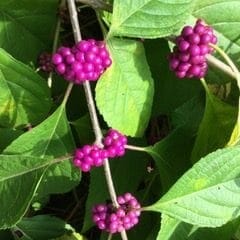GNPS 2018 Plant Of The Year | American Beautyberry
American beautyberry (Callicarpa americana) makes a striking addition to any fall garden thanks to the gorgeous display of berries for which it is named–the genus appellation, Callicarpa, derives from two Greek words meaning “beautiful” and “fruit”. Fittingly for a Plant of the Year, this perennial shrub has more going for it than mere good looks. It is a nutritional powerhouse, providing spring nectar for bees, and year-round sustenance to about forty species of birds, deer, and smaller mammals. It also shows promise as source of natural insect repellent compounds.
American beautyberry thrives in areas that have mild winters and long, humid summers; Georgia provides ideal growing conditions. The shrub is native to the Southeastern US (from Virginia south to Florida and west to Oklahoma and Texas), as well as Bermuda, northern Mexico, and the West Indies. Its natural habitats include woodland margins, pinelands, and forest openings. In such settings, the shrub tends to grow upright with few branches. However, in the garden it can fountain forth an abundance of slender, arching limbs, attaining a height of 8-12’, and almost an equal width.
The plant’s leaves are deciduous, opposite, oval, 3-6” long, tapering at both ends and toothed on the edges. Their color is yellowish green, and they have white hairs on the underside. In May or June, clusters of pale, lavender-pink, tubular flowers appear at the base of the leaf axils. These blossoms are small compared to the leaves and not particularly showy. However, insects love them. They are an important source of nectar for several insect species, most notably bees. American beautyberry is among the plants recommended by the UGA Department of Agriculture and Environmental Sciences Honey Bee program for use in bee meadows (1).

Beautyberry’s fruits appear in late summer and ripen through the fall. At their peak, these glossy “berries” (actually drupes) are an eye-popping shade of magenta. (A less common white form, Callicarpa americana v lactea, is also native to Georgia). Individual drupes–each about ¼” in diameter and containing 4 seeds–join together in tight, ball-like clusters that encircle the branches at the leaf axils. The bright berries persist for some time after the leaves drop in autumn, although they eventually darken and dry out.
Taken together with the foliage, beautyberry’s fruits comprise a multi-season larder for animals. The spring leaves and twigs are high in protein, providing excellent forage for deer. (This browsing rarely damages the plant, and for that reason beautyberry is sometimes described as being deer resistant). In summer through autumn, ripening berries, high in moisture and carbohydrates, are an important source of nutrients for songbirds, quail, and mammals. The latter include rodents, raccoons, foxes, armadillos, and opossums. Dried fruits, seeds, and bark continue to sustain these animals in winter months when other food is scarce. Humans have been known eat beautyberries, too. The fruits are not very tasty raw, but several Internet websites contain recipes for “delicious” beautyberry jelly.
Although American beautyberry’s flowers attract some insects, its foliage strongly repels others. For over a century, crushed beautyberry leaves have been used to keep mosquitos from biting. Modern scientific evidence backs up this folk usage. Researchers at the US Department of Agriculture-Agriculture Research Service in Mississippi have shown recently that several terpenoid compounds extracted from the leaves (callicarpinal, intermedeol, and spathulenol) have the potential to be as effective as DEET in preventing mosquito bites (2,3). These compounds can also deter fire ants from mound building, at least in a laboratory setting (4).


Gardeners will be pleased to know that American beautyberry is easy to grow. It tolerates a variety of soil types, including sand, clay, or rich loam. It is also fairly drought-tolerant, although plants may drop their leaves and ripening berries during a prolonged dry spell. Beautyberries can handle shade; however, some sun is necessary to induce a showy proliferation of berries. Berry production may also be encouraged by cutting back the old branches to 4-6” above the ground in late winter, as flowers and berries form on new growth. An added benefit to pruning is that it will keep plants more compact and less woody. Beautyberries look great in natural settings beneath trees, in large groupings along partly shaded sidewalks or in large beds, or as single accent plants amidst a sea of herbaceous perennials.
One of the qualifications for Plant of the Year is that a species be underutilized in landscapes and gardens. One might claim that beautyberries are already popular garden plants, and that’s true. Unfortunately, the plants that most large garden centers offer are cultivars of Asian species, such as Callicarpa dichotoma or C. bodinieri. Our native American beautyberry is sadly neglected in the commercial trade. As the 2018 Plant of the Year, let’s hope it gets some well-deserved attention.
1) Delaplane, Keith S. (1998) “Bee Conservation in the Southeast.” https://secure.caes.uga.edu/extension/publications/files/pdf/B%201164_2.PDF
2) Cantrell, C.L., Klun, J.A., Bryson, C.T., Kobaisy, M., Duke, S.O. (2005) “Isolation and identification of mosquito bite deterrent terpenoids from the leaves of American (Callicarpa americana) and Japanese (C. japonica) beautyberry.” J. Agric. Food Chem. July 27; 53(15):5948-53.
3) University of Mississipi. (2006). “Scientists confirm folk remedy repels mosquitos.” www.sciencedaily.com/releases/2006/07/060703091932.htm
4) Chen, J., Cantrell, C.L., Duke, S.O., Allen, M.L. (2008) “Repellency of callicarpinal and intermedeol against workers of imported fire ants.” (Hymenoptera: Formidicae). J. Econ. Entemol. 101 (2): 265-271.
FIGURE 1: American beautyberry has stunning fruit.
PHOTO: Valerie Boss
FIGURE 2: The shrub features an open growth habit and arching branches.
PHOTO: Valerie Boss
FIGURE 3: Clusters of tiny flowers attract insects.
PHOTO: Ellen Honeycutt
COPY/PROOFREADING: Valerie Boss
